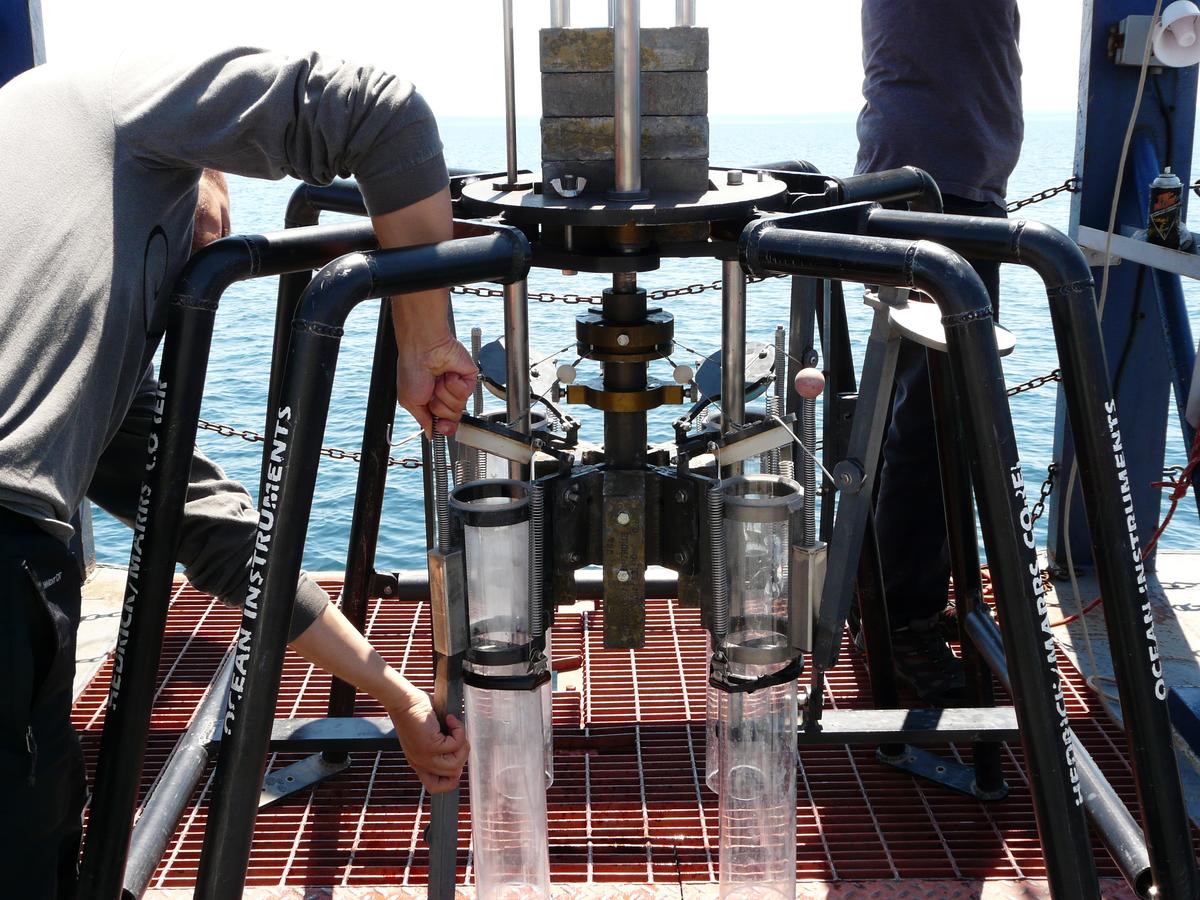In September, the U.S. Environmental Protection Agency announced significant federal investments in Great Lakes research. The funds include $3 million to the Natural Resources Research Institute (NRRI) for collecting and analyzing legacy and emerging chemical contaminants in lake sediments.
This Great Lakes Sediment Surveillance Program will entail collecting sediment samples throughout the entire Great Lakes system, including Canadian waters. Not only is it a massive project by size, there are hundreds of contaminants to analyze – some introduced decades ago and some emerging more recently. Scientists are keen to understand more about the interactions of these contaminants with the environment.
“We’ll analyze over 250 different contaminants, including new contaminants such as pesticides and PFASs – known as ‘forever chemicals’ -- as well as legacy contaminants like lead and mercury,” explained Bridget Ulrich, NRRI Aqueous Geochemist. “Beyond just surveillance, we’re interested in understanding more about what is controlling the way the contaminants are dispersed in the sediment and how they impact the ecology of the lakes.”
These toxic contaminants are harmful to aquatic life in the Great Lakes. They also don’t break down in the environment and can remain in sediments for decades. For example, PFASs are widely used in consumer products such as nonstick cookware and grease-resistant food packaging.
NRRI’s paleolimnology scientists will study sediment deposited as far back as 200 years to understand the historical contaminant record. They’ll also collect surface sediment samples to understand how the contaminants are distributed in the lakes today.
“Layers of sediment are deposited in lakes continuously, leaving us a record of past activity in and around the lakes,” explained Senior Scientist Euan Reavie, a co-principal investigator on the program. “Our team is then able to describe the history of contamination, and whether things are getting better or worse.”
To deliver on this expansive research effort, NRRI has pulled together a large team within the institute and the University of Minnesota Duluth’s Large Lakes Observatory and Swenson College of Science and Engineering.
“The Great Lakes provide critical ecosystem services that coastal communities rely on, like drinking water, fisheries and water for industry,” said the project’s Principal Investigator Christopher Filstrup. “We want to better understand the contaminants, while recognizing that the lakes themselves are changing through time. Understanding these processes is important to ensuring that these services are available for future generations.”
The findings of this five-year project will lead to improved management strategies that more effectively target potentially harmful contaminants and protect ecosystem health.
Meet the Team:
 Principal Investigator and Project Manager Dr. Christopher Filstrup (NRRI)
Principal Investigator and Project Manager Dr. Christopher Filstrup (NRRI)
Filstrup is an applied limnologist with 20 years’ experience studying lake responses to environmental stressors at scales ranging from watershed to continental. He studies basic and applied aspects of aquatic ecosystem functioning, with expertise in limnology, biogeochemical cycling, phytoplankton ecology, and watershed management.
- - -
 Co-Principal Investigator Dr. Euan Reavie (NRRI)
Co-Principal Investigator Dr. Euan Reavie (NRRI)
Reavie will strategize sample collection and will be responsible for oversight of initial sediment processing. Reavie has broad experience with paleolimnology and aquatic ecology with decades of experience reconstructing environmental trends in freshwater aquatic ecosystems and development of indicator tools for lake management.
- - -
 Co-Principal Investigator Dr. Bridget Ulrich (NRRI)
Co-Principal Investigator Dr. Bridget Ulrich (NRRI)
Ulrich will be responsible for leading the trace organic contaminant analyses. Ulrich has over a decade of experience in environmental organic chemistry, including analysis of pesticides, PFASs and explosives. Her expertise is the application of advanced modeling and analytical techniques to assess the behavior of organic contaminants in aquatic environments.
- - -
 Co-Principal Investigator Dr. Kathryn Schreiner (Large Lakes Observatory and UMD Dept of Chemistry & Biochemistry)
Co-Principal Investigator Dr. Kathryn Schreiner (Large Lakes Observatory and UMD Dept of Chemistry & Biochemistry)
Schreiner will be responsible for leading the bulk analysis of collected sediments, including analyzing and interpreting the sources and chemical compositions of natural organic matter in the sediments, which can affect contaminant transport within lakes. Schreiner has over a decade of experience analyzing the organic geochemistry of nearshore sediments, water column particulates, and soils, and has particular expertise in interpreting the source and fate of organic carbon across the land and water interface.
- - -
 Co-Principal Investigator Dr. Chan Lan Chun (NRRI and UMD Civil Engineering)
Co-Principal Investigator Dr. Chan Lan Chun (NRRI and UMD Civil Engineering)
Chun will be responsible for leading microbial community characterization on biogeochemical cycling through molecular biological analysis in collaboration with Dr. Satoshi Ishii (University of Minnesota, Department of Soil, Water and Climate). Chun specializes in evaluating biogeochemical processes in natural and built environments to understand how elemental cycling, microbial activity, and community interactions influence the fate and distribution of pollutant in the environment.
- - -
 Mercury and Heavy Metals Expert Dr. Nathan Johnson (UMD Civil Engineering)
Mercury and Heavy Metals Expert Dr. Nathan Johnson (UMD Civil Engineering)
Johnson will assist with mercury collection protocols, data analysis, and interpretation. Johnson studies the cycling, partitioning and transport of organic and inorganic contaminants, including mercury, in aquatic sediment. He has a history of collaborating with biologists at state and federal agencies to help understand the implications of contaminant inventories and contaminant management strategies on risk assessments.
- - -
 Analytical Chemist Dr. Brian Barry (NRRI)
Analytical Chemist Dr. Brian Barry (NRRI)
Barry will be responsible for overseeing the extraction, partitioning and measurements of the semi-volatile organic contaminants found in sediment. He has over 15 years of experience as a chemist and is a former professor of analytical chemistry with extensive experience running and maintaining analytical equipment.
Learn more about NRRI.
